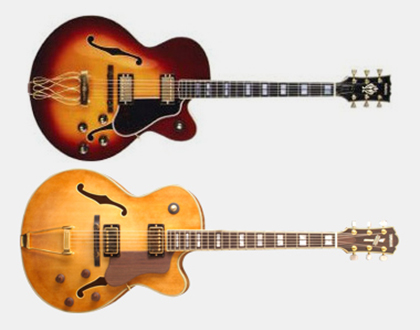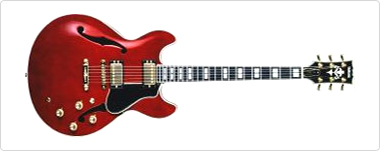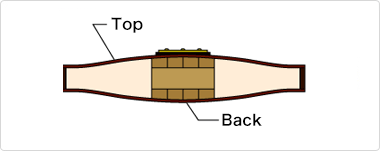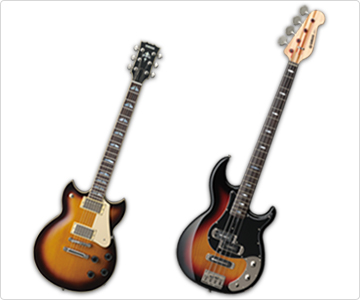The Origins of the Electric Guitar
The electric guitar family
Three major types of instruments
There are three major types of electric guitars: the hollow body guitar, semi-acoustic guitar, and solid-body guitar. Each type differs by timbre and body thickness.
The hollow body guitar has the longest history
Full acoustic guitars are acoustic guitars with pickups attached, so that they can produce enough volume to be played outdoors or in large halls. Their bodies are hollow, so feedback is an ever-present issue. Created in the 1930s, these instruments boast the longest history of all electric guitars. They are often used to play jazz or the blues.

A hollow body guitar with a sound chamber and violin-like f-holes"
Sound produced when plugged into an amp
Full acoustic guitar sound with no amp
Semi-acoustic guitars have thinner bodies than hollow body guitars
Semi-acoustic guitars have thinner bodies than hollow body guitars, and are also called "semi hollow guitars." The central portion of the body is filled with wood, while the left and right sides are hollow. Semi-acoustic guitars produce a sound that is somewhere between that of a hollow body guitar and a solid-body guitar.

Semi-acoustic guitar

Semi-acoustic guitar cross-section view
Sound produced when plugged into an amp
Semi-acoustic guitar sound with no amp
Solid-body guitars feature solid bodies
Solid-body guitars are formed from a solid piece of wood, or from several types of wood joined together and a body filled with wood to eliminate the hollow cavity. When most people think of an electric guitar, they are picturing a solid-body guitar. These instruments come in a variety of shapes. Two examples are introduced below.
The body features distinctive gouges around the base of the fingerboard, so that the guitarist can more easily reach the higher pitch frets. There are typically 21 to 24 frets. However, some instruments can have up to 26 frets! The pitch increases by one semitone each fret. As the pitch increases the space between the frets narrows, making it more and more difficult to press.

A solid-body guitar with three tuning keys on either side of the head

A solid-body guitar with all six tuning keys on one side of the head
An example of playing distortion
Clean
The electric bass is responsible for low tones and rhythm
With a lower pitch than an electric guitar, the electric bass is responsible for the bass register of the song, and also plays a role in providing a sense of rhythm. Although electric guitars tend to have six strings, most electric bass guitars have four. However, there are electric bass guitars with five or six strings. The strings of electric bass guitars are thick and tense and need to be strung with great force. This means that the body needs to be large enough to withstand the vibration of the strings, so electric bass guitars tend to be slightly larger than electric guitars. The neck is also quite long in order to support the longer strings. Placed side by side with an electric guitar, an electric bass appears noticeably larger.

Left: Electric guitar; Right: Electric bass
Musical Instrument Guide:Electric Guitar Contents
Structure
How to Play
How the Instrument is Made
Choosing an Instrument
Care and Maintenance
Trivia
- Slide guitar playing may have been invented in a bar
- Feedback:Great for guitar playing! Not so great for karaoke...
- What is the difference between an electric guitar and electric acoustic guitar?
- Is there a way to eliminate the noise heard when plugged into an amplifier?
- Whole note down tuning for deeper bass
